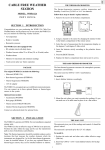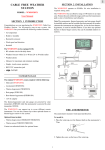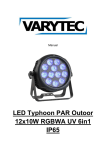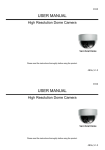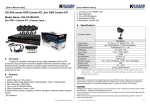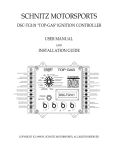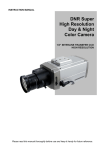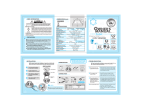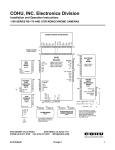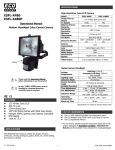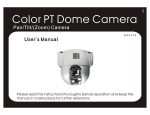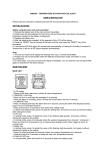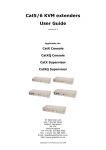Download CCTV Camera Manual
Transcript
CCTV Camera Manual Table of Contents Model configuration Model configuration Precautions Name of each part and Functions - Front - Back 2 3 4-5 6-11 Connection 1. Lens 1) How to use a Fixed Iris lens 2) How to use a DC Iris lens 3) How to use a Video Iris lens 4) How to connect an Auto Iris lens 2. How to adjust C/CS Mount 3. How to connect Power 4. How to connect Monitor 12 12-13 13 13-14 15 16 17 Color Camera ■ STD-Res Series (400 TV Lines, 0.01 Lux/F1.2) DC12V Only DC12V~AC24V, Non polarity Dynamic power input AC230V (AC200~AC240V) ■ STD-Res EX-view Series (400 TV Lines, 0.001 Lux/F1.2 with EX-view HAD CCD) DC12V Only DC12V~AC24V, Non polarity Dynamic power input AC230V (AC200~AC240V) ■ Hi-Res Series (500 TV Lines, 0.03 Lux/F1.2) DC12V Only DC12V~AC24V, Non polarity Dynamic power input AC230V (AC200~AC240V) ■ Hi-Res EX-view Series (500 TV Lines, 0.001 Lux/F1.2 with EX-view HAD CCD) DC12V Only DC12V~AC24V, Non polarity Dynamic power input AC230V (AC200~AC240V) ■ Option 1. IR Sensitive for Day & Night application : Model nr + IR 2. Flickerless Function : Model nr + FL B/W Camera Specification - Color Camera - B/W Camera Trouble shooting guide Note 18 19 20-21 22 Please study the manual thoroughly in order to get the best performance from the camera. 1 ■ STD-Res Series (420 TV Lines, 0.05 Lux/F1.2) DC12V Only DC12V~AC24V, Non polarity Dynamic power input AC230V (AC200~AC240V) ■ Hi-Res Series (600 TV Lines, 0.1 Lux/F1.2) DC12V Only DC12V~AC24V, Non polarity Dynamic power input AC230V (AC200~AC240V) ■ Hi-Res EX-view Series (600 TV Lines, 0.001 Lux/F1.2 with EX-view HAD CCD) DC12V Only DC12V~AC24V, Non polarity Dynamic power input AC230V (AC200~AC240V) This unit has been tested and proved to comply with the limits of FCC rules and CE regulation. 2 Warning ! Name of each part & Functions ☞ To prevent the risk of fire or shock hazard, do not expose this camera to water. Front ☞ Installation of this unit should be carried out by a qualified personnel and should conform to the local codes. Precautions 1. Do not drop or shake the carton severely. The box cannot give perfect protection against heavy shocks. 2. Do not touch the CCD glass by hand, as this may give a blurred picture. 3. Do not expose the camera to water or other liquids. It can cause fire or electric shock. If water or other liquids contaminate the unit, dry it quickly as it can corrode the electrical components inside. 4. Do not install the camera in the wet area or area of high humidity without adequate protection. Moisture can corrode the electrical components inside. 5. Do not turn the camera to face strong light. Direct sunlight or strong reflected light can cause blooming or smearing of the picture. 6. Do not install or use the camera in an environment of extreme temperature. In temperatures of below -10°C use an external housing with heater built in. In a temperatures of over +60°C, cool the camera with ventilation apparatus. 7. Do not disassemble the camera. There are no user serviceable parts inside. 3 1. CCD Protection Cover Leave the cover in place when the lens is not installed. Take it off to fit the lens. 2. C&CS mount This holder moves back and forth by sliding the adjustment lever forwards or backwards. This mechanism is designed for the purpose of using all types of C-Mount or CS-Mount lenses of different manufacturers. Mount the lens on the holder firmly. It is set to CS-Mount position at the factory. Loosen the adjustment lever by turning it counter clockwise a little bit in order to adjust the C&CS mount holder. Set the focus and lock the lever. 3. Adjustment Lever 4. Flange back focus alignment area for C-Mount lens The mount offers 0.5mm of extra tolerance to enable any type of nonstandard C-Mount lens to be focused. Loosen the adjustment lever by turning it counter clockwise a little bit for fine tune focus. 5. Flange back focus alignment area for CS-Mount lens The mount offers 0.5mm of extra tolerance to enable any type of nonstandard CS-Mount lens to be focused. Loosen the adjustment lever by turning it counter clockwise a little bit for fine tune focus. 4 6. Mounting the Bracket Holder Can be attached either on the top or on the bottom. Assemble it with the screws provided. (3 EA) Back -Color DC 12V/AC 24V Line Lock 3. Video Out Connector (BNC Female) 1. 6Way Dip Switch 7. Auto iris lens connector Please refer to page 13, 14 of this manual for the wiring specification. 4. Power Indicator 2. Power Input Terminal 8. Iris mode select switch ES : Electronic auto iris, VI : Video iris, DC : DC Iris ES mode is used with manual iris lenses. In ES mode the camera controls the electronic shutter automatically from 1/50 to 1/100,000 sec.(PAL/CCIR)or 1/60 to 1/100,000 sec.(NTSC/EIA). ES mode with a Manual iris lens is suitable for indoor surveillance. Select the slide SW to the ES position. 5. Line Lock / White Balance Push button DC 12V AC 230V Power Cord For outdoor use, ES mode is not sufficient. In this case an Auto Iris lens of either Video driven type or DC driven type is recommended. Move the slide SW to VI position for the Video iris lens or move it to DC position for the DC Iris lens. When VI or DC mode is selected, the electronic shutter speed is fixed to 1/50sec(PAL/CCIR) or 1/60sec(NTSC/EIA). 9. DC Level control for DC Iris lens. It is used for controlling the video output level of the DC driven auto iris lens. * To make the image brighter, turn the pot clockwise. * To make the image darker, turn the pot counter clockwise. 1-1. 6 Way DIP Switch DIP Switch configuration (24V AC LineLock, 230V AC LineLock only) No. ON OFF 1 (Phase Push SW up/down)Line Lock Mode Internal Mode 2 OFF ON Manual White Balance Auto White Balance 3 ON (Adjust the Push Button Up/Down) OFF (No need to Adjust the Push Button) 4 5 6 =0.45 =1.0 AGC Max : 26dB AGC Normal : 20dB BLC OFF BLC ON DIP Switch configuration (DC 12V only) No. ON OFF 1 OFF ON Auto White Balance Manual white Balance 2 ON (Adjust the Push Button Up/Down) OFF (No need to Adjust the Push Button) =0.45 =1.0 3 AGC Normal : 20dB AGC Max : 26dB 4 5 6 5 BLC OFF BLC ON N.C N.C 6 * Color 6 Way Dip Switch Functions Sync Mode Selection(L/L BLC (Back Light Compensation) ON / OFF (BLC INT) * INT(Internal Sync) Mode This mode is used when the camera is installed outoor with one camera to one monitor operation. ON) Under bright lighting conditions from behind the subject, the camera will close the iris automatically. Select BLC mode to counteract this. In normal lighting conditions, select BLC to OFF. It is set to OFF at the factory. 1-2. Power Input Terminal * L/L(Line Lock) Mode : To work with other cameras using 24VAC and 230VAC power, it is required to synchronize the video signals in order to remove picture fluctuation problems. In the case of one camera with one monitor under fluorescent lighting, the picture is affected by the 24VAC and 230VAC power frequency in INT mode. A flickering picture may result from this condition. Set Dip S/W to L/L mode to remove this problem. It is set to L/L at the factory. This terminal provides connections for DC 12V or AC 24V. It is not polarity sensitive. The unit has a wide power tolerance, within DC 10V~DC 40V or within AC 15V~AC 30V. It is not a special requirement to use a regurated power supply, but using a regurated supply is recommended. 1-3. Video Out Jack (BNC Female) Connect Coaxial cable from this BNC connector to the monitor. Use a high quality coaxial video cable to ensure good picture quality over long distances. White Balance Control W W * WBA (White Balance Auto) mode ( B B) A M The camera controls the white balance automatically. It is recommended for most applications. It is set to WBA at the factory. W W * WBM (White Balance Manual) Mode( B B) A M White balance is controlled manually under this mode by adjusting the push button up or down. It is not used for normal applications. It may needed for special conditions or when the camera is used under special lighting. The back ground of the picture may become red or blue under manual adjustment. Gamma Correction Select Mode ( =1.0 0.45) Select 1.0 when the picture needs to be darker in contrast. It is set to 0.45 at the factory. Option : Flickerless Select Mode ( FL OFF) FL ON(NTSC:1/100 sec, PAL:1/120 sec) Automatic Gain Control (MAX AGC) Use this mode for dark illumination or at night. If the MAX(AGC Max) is selected the camera increases the video signals to maximum so that the picture looks brighter. At MAX mode, unnecessary noise is increased also and the picture may display noise on the screen. This is normal. It is set to AGC at the factory. 7 1-4. Power Indicator Red power lamp turns on when the power is properly supplied. 1-5. Vertical Phase Adjustment Push Button (Line Lock mode) White Balance Push button The up/down push buttons control V phase at L/L mode and control manual white balance at the WBM mode. ◆ At the L/L Mode When the unit is used with system equipment and other cameras, it is required to synchronize the Vertical Phase between the cameras when using 24VAC. It is recommended to use a multi-channel oscilloscope for correct adjustment. Push the buttons once at a time up or down when vertical phase of the unit does not match the other cameras or system equipment. ◆ At the WBM (White Balance Manual) Mode Adjust the white balance with the push buttons when the camera is used with the special lighting such as sodium lamps. Usually it is not used for security applications. These two functions cannot be adjusted at the same time. Adjust each mode in turn. 8 Back -B/W * B/W 4 Way Dip Switch Functions DC 12V/AC 24V Line Lock Sync Mode Selection(L/L 3. Video Out Connector (BNC Female) 1. 4Way Dip Switch 4. Power Indicator 2. Power Input Terminal 5. V.R AC 230V Power Cord Line Lock Cord DC 12V INT) * INT(Internal Sync) Mode This mode is used when the camera is installed outoor with one camera to one monitor operation. * L/L(Line Lock) Mode : To work with other cameras using 24VAC power, it is required to synchronize the video signals in order to remove picture fluctuation problems. In the case of one camera with one monitor under fluorescent lighting, the picture is affected by the 24VAC power frequency in INT mode. A flickering picture may result from this condition. Set Dip S/W to L/L mode to remove this problem. It is set to L/L at the factory. Gamma Correction Select Mode ( =0.45 1.0) Select 1.0 when the picture needs to be darker in contrast. It is set to 0.45 at the factory. Automatic Gain Control (AGC MAX) Use this mode for dark illumination or at night. If the MAX(AGC Max) is selected the camera increases the video signals to maximum so that the picture looks brighter. At MAX mode, unnecessary noise is increased also and the picture may display noise on the screen. This is normal. It is set to AGC at the factory. 1. 4 Pin DIP Switch DIP Switch configuration (24V AC LineLock) No. OFF 1 INT 2 =0.45 3 BLC OFF 4 AGC Normal : 20dB DIP Switch configuration (DC 12V & 230V AC) No. OFF 1 =0.45 2 BLC ON 3 AGC Normal : 20dB 4 N.C 9 ON L/L =1.0 BLC ON AGC Max : 32dB BLC (Back Light Compensation) ON / OFF (BLC OFF) Under bright lighting conditions from behind the subject, the camera will close the iris automatically. Select BLC mode to counteract this. In normal lighting conditions, select BLC to OFF. It is set to OFF at the factory. ON =1.0 BLC OFF AGC Max : 32dB N.C 10 2-2. Power Input Terminal Connection This terminal provides connections for DC 12V or AC 24V. It is not polarity sensitive. The unit has a wide power tolerance, within DC 10V~DC 40V or within AC 15V~AC 30V. It is not a special requirement to use a regurated power supply, but using a regurated supply is recommended. 2-3. Video Out Jack (BNC Female) Connect Coaxial cable from this BNC connector to the monitor. Use a high quality coaxial video cable to ensure good picture quality over long distances. 1. Lens It is recommended to use a good quality lens to improve the picture quality under low light conditions. The camera is built with a universal mounting mechanism on which any type of lens can be used. * Lens is not supplied with camera. How to use a Manual Iris lens 2-4. Power Indicator Red power lamp turns on when the power is properly supplied. 2-5. Vertical Phase Adjustment V.R (Line Lock mode) * In this set-up the camera does not control the iris. Instead the camera adjusts the picture automatically for light changes. Set the Iris mode select switch to ES (Electronic Shutter) position. ◆ At the L/L Mode When the unit is used with system equipment and other cameras, it is required to synchronize the Vertical Phase between the cameras when using 24VAC. It is recommended to use a multi-channel oscilloscope for correct adjustment. Adjust vertical phase of the unit with V.R to match with other cameras or system equipment. * Please make sure to check this before operation. When the S/W is positioned at the VI or DC mode, the electronic shutter will be off and will not control the picture. How to use a DC Iris lens 11 12 2 * Set the iris mode select switch to DC (DC driven automatic iris Control) position. * In this mode, the iris is controlled automatically to react to DC signals from the camera. * Please make sure to set S/W to DC position before you operate the camera with a DC lens. * DC level control is on the side of the camera. Please do not touch the DC Level control when using a fixed or Video iris type of lens. * The camera is set to DC at the factory. Adjust the pot up or down only when you need the picture to look brighter or darker depending on the situation. Generally there is no need to adjust the level. * Remove the cover of the auto iris plug connector(supplied with the camera) and solder the lens cable to the pins as per the following configuration: How to use a Video Iris lens * Set the iris mode select switch to VI (Video signal driven Automatic Iris) position. * In this mode the lens controls itself automatically to react to Video signals from the camera. * Video type * Please make sure to set S/W to VI position before you operate the unit with a Video type auto iris lens. Level control is on the side of the lens . How to connect an Auto Iris lens (DC / Video) * Take off the insulation of the lens cable as shown on the drawing. (approx. 8mm) * Take off the insulation of the inner cable as shown on the drawing. (approx. 2mm) 13 1 * DC type * Video type * DC type No. 1 Pin --- Red(Power source) No. 2 Pin --- N.C No. 3 Pin --- Yellow(Video Signal) No. 4 Pin --- Black(GND) No. 1 Pin --- DAMP No. 2 Pin --- DAMP + No. 3 Pin --- Drive + No. 4 Pin --- Drive - Remove the Protection Cap and attach the lens to the camera. Set the Iris mode select switch, S/W to VI, ES or DC position according to the type of lens. Connect the lens plug to the auto iris socket located on the left side of the camera. 14 2 2. How to adjust C&CS Mount 3. How to connect power 3-1. Please check the model and power specification before connecting the power. 3-2. AC24V power The camera has a common power input connector for both 12VDC and 24VAC. The power input is non polarized. Loosen the lens mount holder by turning the adjustment lever clockwise. Pull the adjustment lever backward and fix it on the “CS” position. Turn the lever counter clockwise to tighten. Push the lever forward and fix it on the “C” position. Turn the lever clockwise to tighten. C-Mount CS-Mount Hold the levers at both side together and move the lens mount holder forward or backward. Color B/W 3-3. The unit has a wide power tolerance, within DC 10V ~ DC 40V or within AC 15V ~ AC 30V. 3-4. DC 12V power Use regulated DC 12V power supply ONLY. The power input is non polarized. 3-5. AC 230V power Use an AC 230V power source. Connect the power plug to the outlet directly. WARNING ! CONNECT POWER ONLY AFTER INSTALLATION IS COMPLETED. Refer to page 4 for any additional information. 15 1 16 2 4. How to connect to monitor Specification (Color) 4-1. Connect the Video out jack to the Video In jack on the monitor. - Use good quality shielded coaxial video cable to avoid noise interference. - Connect the cable with the power turned off. Camera Back Monitor - When the camera is used with multi-channel equipment or with more than 2 monitors, please set impedance level switch on the interim equipment / monitors to HI-Z position and make sure to set the last monitor to 75 position. INTERIM EQUIPMENTS OR MONITOR CAMERA 17 1 LAST MONITOR MODEL STD-Res Series Hi-Res Series Image sensor 1/3" SONY HAD IT CCD Option : 1/3" EX-View HAD CCD, SONY Effective Pixels NTSC:512(H)X492(V) PAL:500(H)X582(V) NTSC:768(H)X494(V) PAL:752(H)X582(V) H.Resolution 400 TV Lines 500 TV Lines Synchronizing system Internal Internal/Line Lock Line Lock Only Internal Internal/Line Lock Line Lock Only Scanning system NTSC 525 Lines PAL 625 Lines 2:1 Interlaced Video output 1.0Vp-p Composite. 75 Ohms S/N ratio More than 50 dB (AGC Off) Min. Illumination STD : 0.01 Lux at F1.2 High-Res : 0.03 Lux at F1.2 EX-View : 0.001 Lux at F1.2 BLC ON/OFF by Dip Switch Shutter Speed NTSC : 1/60~1/100,000 sec PAL : 1/50~1/100,000 sec Gamma correction Standard 0.45 Switchable 1.0 by Dip Switch White Balance Standard 2100°K ~ 9100°K Auto Manual setting by Dip S/W & Up/Down by Push BTN Gain Control Standard : 8dB~30dB Auto Maximum by Dip switch Smear Effect 0.005% MTBF 80,000 hours Power source DC12V DC12V-AC24V Dynamic AC230V DC12V DC12V-AC24V Dynamic AC230V Operating current 150mA, 110mA 30mA 130mA 150mA, 110mA 30mA 130mA Lens C-Mount (17.5mm Frange back) ~ CS-Mount (12.5mm Frange back) & Fine focus 1.0mm Iris Control Video Iris/ESC/DC Iris Operating Temperature 14° F~122° F ( -10° C~ + 50° C ) Humidity Within 90% RH Measurement(mm) 50(W) x 50(V) x 115(L) Weight(Approx.g) 410 310 410 310 310 310 Yes IR Sensitivity Yes Optional Audio Features Dual Power 12~24 12V DC Only Line Lock ON/OFF BLC STD/MAX AGC Dip S/W 0.45/1.0 Gamma Control WBA / WBM Line Lock BNC Video Out Red LED Power Indicator Rear Power Input terminal Screw Joint Pannel Line phase push BTN W/B adjust push BTN Up/Down Dip S/W 6 Way Auto Iris jack 4Pin Jack Side Iris Mode Slide S/W VI ES DC Pannel DC Iris Adjust volume DC Level Yes Yes Yes Yes Yes Yes Yes Yes Yes Yes Yes Yes 12V DC Only Yes Yes Yes Yes ON/OFF ON/OFF ON/OFF ON/OFF ON/OFF STD/MAX STD/MAX STD/MAX STD/MAX STD/MAX 0.45/1.0 0.45/1.0 0.45/1.0 0.45/1.0 0.45/1.0 White Balance Auto/WB Manual adjustment ON/OFF ON/OFF BNC BNC BNC BNC BNC Red LED Red LED Red LED Red LED Red LED Screw Joint 230V AC VDE Code Screw Joint Screw Joint 230V AC VDE Code Up/Down Up/Down Up/Down Up/Down Up/Down Up/Down Up/Down Up/Down Up/Down 6 Way 6 Way 6 Way 6 Way 6 Way 4Pin Jack 4Pin Jack 4Pin Jack 4Pin Jack 4Pin Jack VI ES DC VI ES DC VI ES DC VI ES DC VI ES DC DC Level DC Level DC Level DC Level DC Level 18 2 Specification (B/W) MODEL Image sensor Effective Pixels H.Resolution Synchronizing system Scanning system Video output S/N ratio Min. Illumination Trouble Shooting Guide STD-Res Series 1/3" Interline CCD, SONY Hi-Res Series 1/3" Interline CCD, SONY Option : EX-View HAD CCD Version EIA:512(H)X492(V) CCIR:500(H)X582(V) EIA:768(H)X494(V) CCIR:752(H)X582(V) 420 TV Lines 600 TV Lines Internal Internal/Line Lock Internal Internal Internal/Line Lock Internal EIA 525 Lines CCIR 625 Lines 2:1 Interlaced 1.0Vp-p Composite. 75 Ohms More than 50 dB (AGC Off) 0.1 Lux at F1.2 Option : 0.001 Lux at F1.2 (EX-View HAD CCD version) 0.05 Lux at F1.2 BLC ON/OFF by Dip Switch Shutter Speed EIA : 1/60~1/100,000 sec CCIR : 1/50~1/100,000 sec Gamma correction Standard 0.45 Switchable 1.0 by Dip Switch Gain Control Standard : 4dB~30dB Auto Maximum by Dip switch Smear Effect 0.005% MTBF 80,000 hours Power source DC12V DC12V-AC24V ( 4V) Dual AC230V( 30V) DC12V DC12V-AC24V ( 4V) Dual AC230V( 30V) Operating current 110mA 100mA, 50mA 20mA 110mA 100mA, 50mA 20mA Lens C-Mount (17.5mm Frange back) ~ CS-Mount (12.5mm Frange back) & Fine focus 1.0mm Video Iris/ESC/DC Iris Iris Control Operating Temperature 14° F~122° F ( -10° C~ + 50° C ) Humidity Within 90% RH Measurement(mm) 50(W) x 50(V) x 115(L) Weight(Approx.g) 310 410 310 310 410 310 ON/OFF ON/OFF Line Lock 0.45/1.0 0.45/1.0 0.45/1.0 0.45/1.0 0.45/1.0 0.45/1.0 Dip S/W Gamma ON/OFF ON/OFF ON/OFF ON/OFF ON/OFF ON/OFF Control BLC STD/MAX STD/MAX STD/MAX STD/MAX STD/MAX STD/MAX AGC Video Out BNC BNC BNC BNC BNC BNC Power Indicator Red LED Red LED Red LED Red LED Red LED Red LED Rear Power Input terminal Screw Joint Screw Joint 230V AC VDE Code Screw Joint Screw Joint 230V AC VDE Code Pannel Phase V.R YES YES Dip S/W 4Way Slide 4Way Slide 4Way Slide 4Way Slide 4Way Slide 4Way Slide Auto Iris jack 4Pin Jack 4Pin Jack 4Pin Jack 4Pin Jack 4Pin Jack 4Pin Jack Side Iris Mode Slide S/W VI ES DC VI ES DC VI ES DC VI ES DC VI ES DC VI ES DC Pannel DC Iris Adjust volume DC Level DC Level DC Level DC Level DC Level DC Level 19 1 If the unit continues to be fault after the following adjustments please consult your dealer. When the picture is not displayed on the monitor - Please check if the AC-DC power unit is plugged into the AC power outlet firmly - Please check if there are any misconnection’s in the cabling. - Please check if the IRIS mode select switch is set to the correct position i.e. to the DC mode for the DC driven auto iris lens or VI mode for the Video driven auto iris lens. When the picture is blurred - Please check if the lens is contaminated. Please clean the lens surface (on both sides) gently with a soft cloth or tissue. - Please check if the lens is focused properly. - When you use a manual iris lens, the iris select switch should be positioned to the ES mode. - Please check if the monitor is set to brightly. Adjust the brightness or contrast level on the monitor correctly. When the color displayed on the monitor is not correct(for Color) - Please check if the White Balance switch is set to WBM position. White balance is controlled automatically under the WBA mode for most situations. When the camera is used under special lighting conditions, please refer to page 7 in this manual. - Please check if the monitor’s color adjustment is set correctly. When the picture is too dark - Please check if the monitor’s contrast is set too dark. - Please check if the Gamma select switch is set to 1.0 on the 6th pin of the DIP switch. If it is please move it to the 0.45 position. Gamma 1.0 position is recommended for use with a LCD monitor. - Please check if the camera is positioned toward a door or window. Please set BLC ON is these conditions. 20 2 Note When the picture is too bright - Please check if the monitor’s brightness control is get too high. - Please check if the camera is set to BLC ON under normal lighting conditions.( i.e. when the camera is not pointed towards a brightly lit area) Please move the BLC select switch to the BLC OFF position. When there is noise on the picture in dark illumination conditions - The camera picture becomes noisy under AGC MAX mode in order to increase the video gain in poor lighting conditions. Please move the AGC switch to OFF position if it is not required. When the picture is not clear on the monitor - Please check if the monitor is set up correctly. - Please check if the camera is pointer towards an area where too much light comes in. Adjust the direction of the camera in this case. - Please check if the back focus of the lens is set correctly. When the picture is flickering - Please check if the camera is pointed at fluorescent lighting or bright sunlight. Use a visor or adjust the direction of the camera in this case. - Please check if the Auto iris lens is selected correctly on the IRIS mode select switch. Please move the Iris mode switch to DC position when you use a DC type auto lens or move it to the VI position when you use a Video type auto iris lens. - When you don't use an auto iris lens, please move the iris select switch to the ES position When the picture is distorted - Please check if the lens is defective and replace the lens in this case. - Please check if the camera is PAL/CCIR(50Hz) in an NTSC/EIA(60Hz) area or vice versa. 21 1 22













